For 90 Years, Kenworth Has Developed Innovations Focused on Customer Needs
Kenworth 90th Anniversary Celebration
Kenworth's core values of quality, innovation and technology have remained steadfast in its efforts to build The World's Best® trucks for customers throughout the company's 90-year history.
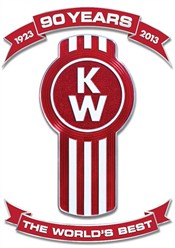
"Innovation has been a part of Kenworth's heritage since its founding. Our engineers have always looked for ways to use the latest technology to build efficient trucks that provide transportation solutions to our customers, and that tradition continues today," said Kurt Swihart, Kenworth marketing director.
During the 1930s, Kenworth's engineers were challenged to help reduce operating costs and improve productivity of truck operators during the Great Depression, and inspire them to buy new trucks again. For its first 10 years, Kenworth had successfully produced durable, gasoline-powered trucks that handled the punishing environment of the Pacific Northwest.
"The Depression was hard on the region's economy and new truck sales. Kenworth engineers needed to come up with something innovative that would encourage sales, yet also save customers money during the tough times," said Swihart.
Kenworth's First Truck with Factory-Installed Diesel Engine
Kenworth's answer was diesel engine technology. Diesel prices were just a third of the price of gasoline, and the diesel engine possessed much higher energy efficiency. Kenworth engineer Murray Aitken drew up plans to install the 100-hp Cummins HA-4 diesel engine as original equipment. And chief engineer John Holmstrom added his idea - vertical exhaust pipes behind the truck's cab.

First Kenworth Diesel Truck in 1933
In 1933, Kenworth built its first truck with a diesel engine as original equipment. By adding the diesel engine, which was a new technology for trucks, Kenworth became a national name. Kenworth's first diesel-powered production model was built for California-based Valley Motor Express, which requested the truck be shipped down the West Coast from Seattle most of the way by water so it would arrive truly new.
Kenworth's First Integrated Sleeper
With the advent of diesel engines into trucks in the 1930s, longer truck routes - such as from Seattle to Los Angeles or Los Angeles to Chicago - became more economically viable. Those longer routes meant drivers required rest on the road.
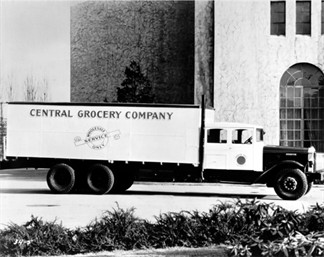
First Kenworth Integrated Sleeper in 1933
In response, Kenworth introduced another important technology in 1933 by integrating the sleeper into the truck. Drivers could now save some money by sleeping in their trucks instead of at a motel. It also became more convenient to find a place just off the highway to rest when tired, instead of having to travel another 100 miles to reach the closest motel.
"While it was nothing like our sleepers today, Kenworth's first integrated sleeper gave the driver just enough room to lie down and get some good rest before continuing on the road," Swihart said.
Kenworth 853 Performance Establishes Kenworth's Reputation Worldwide
Kenworth's engineering expertise reaches beyond over-the-road or long-haul applications to solve problems faced by vocational application customers. In 1947, Kenworth engineers designed the innovative Kenworth 853 - a special-purpose truck used by the Arabian-American Oil Company (ARAMCO) to build the Trans-Arabian Pipeline, then the world's largest construction project.
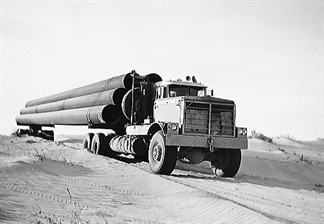
Kenworth 853
The Kenworth 853, which had to withstand temperatures of up to 135 degrees Fahrenheit in the Saudi Arabian desert, featured a 64,000-pound capacity, side-by-side radiators, 6-wheel drive, a 300-gallon fuel capacity and a 318-hp engine.
"The Kenworth 853 performed well, and had the superior stability and traction - aided by its low-pressure, balloon-type tires - required to haul huge oil rigs and other heavy loads across the deep sands of Saudi Arabia," said Alan Fennimore, Kenworth's vocational marketing manager. "The 853 firmly established Kenworth's reputation worldwide and opened the door for Kenworth to sell more trucks throughout the Middle East, Africa and elsewhere." This model led to the 953, and then the K953 cabover, predecessor to the current K500 cabover that is Kenworth's premier model for oil and gas exploration worldwide today.
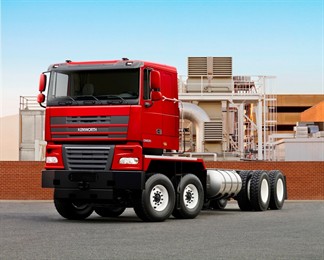
Kenworth K500 Cabover
Kenworth 853 Kenworth Develops Enhanced Aerodynamics To Reduce Operating Costs
Following the Arab Oil Embargo of the 1970s, the resulting volatile fuel prices and shortages made fuel economy a chief concern among truck operators. In response, Kenworth engineers developed the industry's first truly aerodynamic model, the Kenworth T600 with its sloped hood. In testing, the T600 turned out to be 22 percent more fuel efficient than a straight hood conventional.
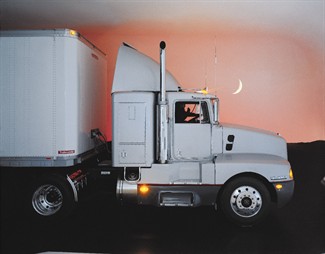
Kenworth T600
While the Kenworth T600's sloped hood drew most of the attention, the truck was loaded with other innovations. A set-back front axle allowed for easier front axle loading. New 64-inch taper-leaf springs provided a much improved ride, and the turning radius was 23 percent less than on other conventional trucks. The new design reduced splash and spray by 50 percent, to the great benefit of other vehicles on the road.
In 1994, Kenworth received the U.S. Department of Transportation's National Award for the Advancement of Motor Vehicle Research and Development, in recognition of the T600's advancements in safety, energy savings and reduced environmental impact.
Innovation Tradition Continues
The legacy of innovative engineering continues today as Kenworth engineers develop efficient trucks for customers' needs.
Kenworth built on the success of the market's first truly aerodynamic truck - the Kenworth T600, introduced in 1985 - by engineering the Kenworth T680, the most aerodynamic truck in the company's history.
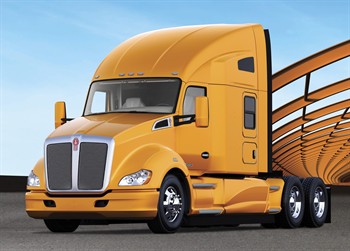
Kenworth T680
Introduced in 2012, the T680 was designed with extensive input from fleet managers, maintenance managers and drivers. The T680's 76-inch integrated sleeper with a full-height roof, goes far beyond Kenworth's first integrated sleeper in 1933, and provides drivers more room to live and work on the road along with numerous driver comfort amenities.
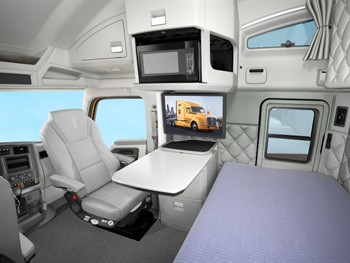
Kenworth T680 Interior
And as with Kenworth's introduction of its first diesel engine to customers 80 years earlier, Kenworth continues to help customers lower their fuel bills by offering the latest in engine technology - the PACCAR MX-13. Rated up to 500 hp and 1,850 lb-ft of torque, the engine utilizes common rail fuel-delivery technology, enabling injection pressures of up to 2,500 bar, significantly enhancing fuel efficiency and performance.
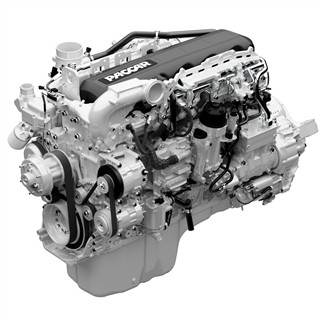
PACCAR MX-13 Engine
"Throughout the years, Kenworth has continued the process of developing and fine-tuning the right truck with the right specifications for the right application by working closely with customers. The result has been cutting-edge designs using the latest in technology to help Kenworth truck operators get the best performance and most productivity," said Swihart.
"In the end, it's always been about emphasizing quality, innovation and technology to build The World's Best® trucks for our customers," said Swihart.
Kenworth Truck Company is the manufacturer of The World's Best® heavy and medium duty trucks. Kenworth's Internet home page is at www.kenworth.com. Kenworth is a PACCAR company.
